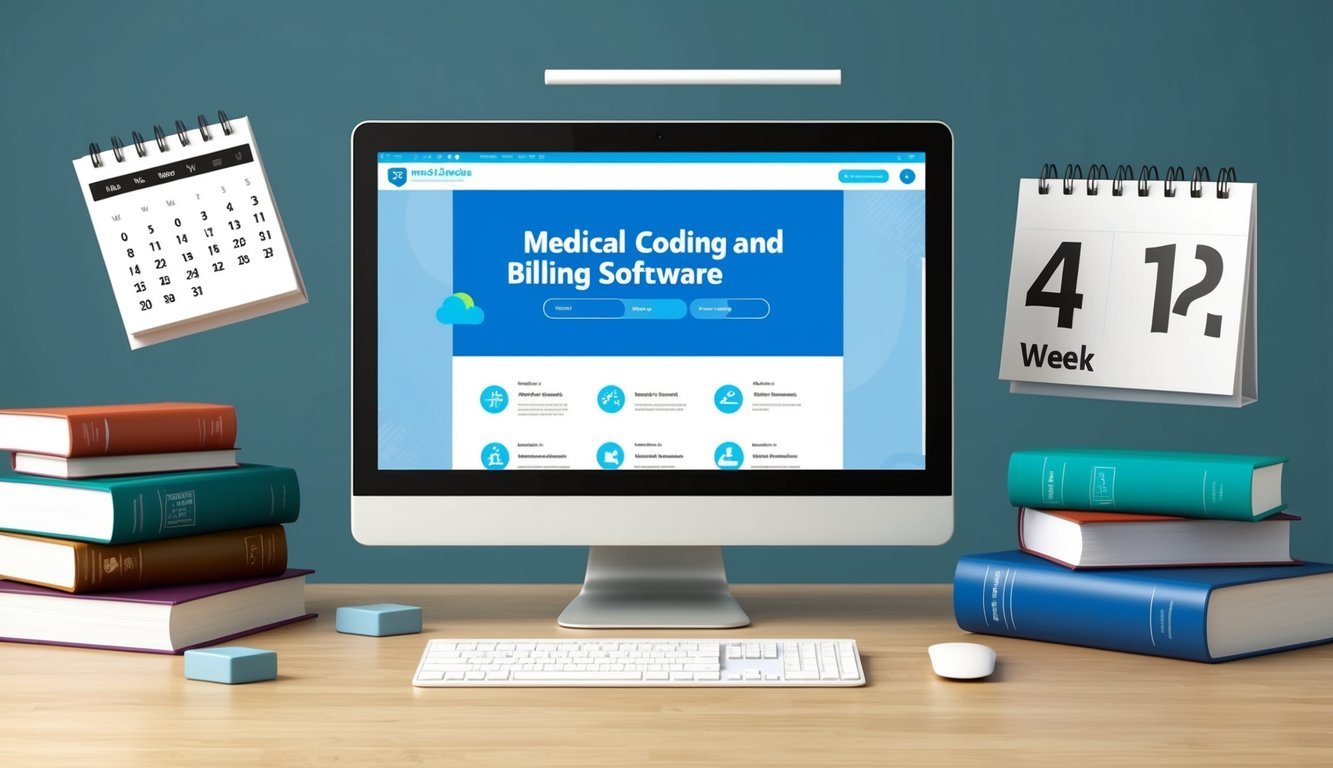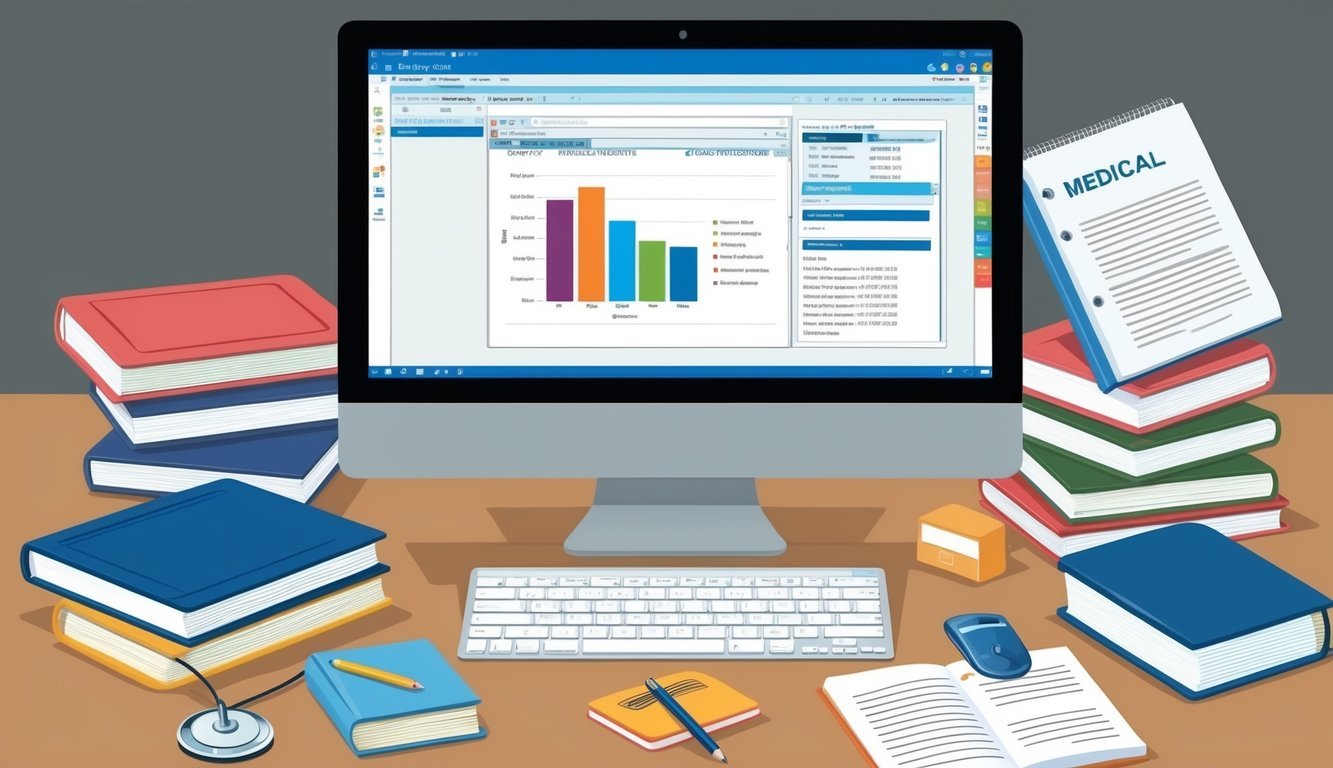If you’re considering a career in healthcare, medical billing and coding might be the perfect path for you. Many online programs offer 4-week courses that can help you quickly gain the essential skills needed for professional certification in this growing field.
These accelerated courses often provide a flexible learning environment that fits your busy schedule.
You can study at your own pace.
In just four weeks, you can acquire knowledge about medical terminology, coding systems, and billing procedures to prepare for entry-level positions.
With programs available in various formats, including asynchronous and synchronous classes, you have the opportunity to choose a learning style that suits your needs.
Exploring online options can be highly beneficial, as they often offer comprehensive curricula designed to meet industry standards.
Completing a 4-week online course in medical billing and coding not only enhances your resume but also opens doors to job opportunities in hospitals, clinics, and insurance companies.
As the demand for skilled professionals continues to rise, investing in your education through these quick and efficient programs can significantly boost your career trajectory.
Foundations of Medical Billing and Coding

Understanding the foundations of medical billing and coding is essential for anyone entering the healthcare field.
This knowledge equips you with the skills needed to navigate the complexities of health information management and billing processes effectively.
Medical Terminology and Anatomy
Medical terminology is the language used in healthcare.
Familiarity with terms allows you to communicate efficiently with healthcare professionals and ensures accurate coding of diagnoses and procedures.
- Key Components:
- Root Words: Form the basis of medical terms (e.g., “cardio” for heart).
- Prefixes and Suffixes: Modify root words to provide additional context (e.g., “tachy” means fast, so “tachycardia” means fast heart rate).
You should also have a solid grasp of human anatomy.
Understanding body systems, such as the respiratory and circulatory systems, allows you to apply appropriate codes in billing and coding practices.
Resources like MedlinePlus can enhance your knowledge further.
Healthcare Systems and Settings
Healthcare systems encompass various facilities such as hospitals, clinics, and long-term care facilities.
Each system has distinct procedures, policies, and billing rules.
- Types of Healthcare Facilities:
- Acute Care Hospital: Provides short-term treatment for severe injuries or illnesses.
- Outpatient Clinic: Offers services without staying overnight, focusing on preventive care.
You must understand the nuances of each setting, as they impact coding practices and insurance reimbursements.
Knowledge of policies governing these systems is crucial for effective medical billing.
Explore resources such as Healthcare.gov for additional insights.
Medical Coding Principles

Understanding the foundational aspects of medical coding is crucial for anyone pursuing training in this field.
You’ll learn about the coding systems and practices employed in both outpatient and inpatient settings.
ICD-10, CPT, and HCPCS Coding Systems
The International Classification of Diseases, Tenth Revision (ICD-10) is essential for diagnosing conditions.
It features a comprehensive set of codes used primarily for inpatient coding.
Current Procedural Terminology (CPT) is vital for documenting medical, surgical, and diagnostic procedures, ensuring accurate billing for services rendered.
The Healthcare Common Procedure Coding System (HCPCS) complements ICD-10 and CPT by covering items not included in CPT, such as durable medical equipment (DME).
Below is a comparison of these coding systems:
| Coding System | Usage | Focus |
|---|---|---|
| ICD-10 | Diagnoses | Diseases and conditions |
| CPT | Procedures and services | Healthcare procedures |
| HCPCS | Non-physician services and items | DME, supplies, and services |
Outpatient and Inpatient Coding
Outpatient coding involves assigning codes for patients who receive care without being admitted to a hospital.
This type of coding typically utilizes the CPT and ICD-10 codes.
It is crucial to capture all services accurately for proper reimbursement.
Inpatient coding involves coding for patients who are admitted to a hospital.
It requires a deeper understanding of the ICD-10 system, as conditions often require more detailed documentation for complex treatment scenarios.
Risk adjustment coding is further applied here to ensure the accuracy of risk assessments and reimbursements, particularly for Medicare and Medicaid patients.
Medical Billing and Reimbursement Process
Understanding the medical billing and reimbursement process is essential for ensuring accurate financial management in healthcare.
This section focuses on how insurance claims are processed and outlines the revenue cycle alongside patient financial responsibilities.
Insurance Claims and Processing
Submitting insurance claims is a critical step in the medical billing process.
You will need to gather patient and provider information to ensure all details are accurate.
Here are key steps in claims processing:
- Insurance Verification: Confirm the patient’s coverage before services are rendered. This avoids claim denials and ensures the correct billing cycle.
- Claim Submission: Use medical billing software to submit claims electronically. Ensure compliance with the payer’s guidelines to prevent delays.
- Claims Processing: After submission, the insurance company reviews the claim for completeness and accuracy. They will determine the reimbursement amount based on contract agreements.
- Denial Management: If a claim is denied, analyze the reason and resubmit as necessary.
Proper management of these steps aids in timely reimbursements and minimizes financial disputes.
Revenue Cycle and Patient Financial Responsibility
The revenue cycle encompasses all financial processes from patient registration to payment collection.
Here’s a breakdown:
- Patient Registration: Collect financial and insurance information upfront. This sets the foundation for financial responsibility.
- Billing: After services are provided, generate bills that reflect the services performed. Include codes for services and CPT/HCPCS codes for accurate billing.
- Payment Collection: Communicate clearly with patients about their financial responsibilities. Utilize billing software to track payments and outstanding balances.
It’s essential to educate patients about their co-pays, deductibles, and any financial aid options available to them.
Understanding these aspects ensures smoother transactions and enhances the overall patient experience.
Online Learning and Course Management

Engaging in online medical billing and coding courses requires effective navigation of the virtual classroom and strong time management skills.
You will benefit from understanding course materials and assignments, ensuring your success throughout the program.
Navigating the Online Classroom
When you enroll in an online course, familiarize yourself with the platform used for course management, such as Moodle or Blackboard.
These systems are designed to streamline your learning experience.
Key features to explore include:
- Course Dashboard: Access all your modules and grades.
- Discussion Boards: Engage with instructors and peers.
- Resource Library: Find essential course materials and reference documents.
It’s crucial to maintain consistent communication with your instructor.
Participating in discussion forums can also enhance your learning, helping you grasp complex coding concepts effectively.
Time Management and Assignments
Engaging in online medical billing and coding courses requires effective navigation of the virtual classroom and strong time management skills.
You will benefit from understanding course materials and assignments, ensuring your success throughout the program.
Navigating the Online Classroom
When you enroll in an online course, familiarize yourself with the platform used for course management, such as Moodle or Blackboard.
These systems are designed to streamline your learning experience.
Key features to explore include:
- Course Dashboard: Access all your modules and grades.
- Discussion Boards: Engage with instructors and peers.
- Resource Library: Find essential course materials and reference documents.
It’s crucial to maintain consistent communication with your instructor.
Participating in discussion forums can also enhance your learning, helping you grasp complex coding concepts effectively.
Time Management and Assignments
Time management is vital for balancing coursework with personal commitments.
Typically, a four-week program will have structured timelines for completing assignments and study materials.
To stay organized:
- Create a Weekly Schedule: Designate specific times for study sessions.
- Set Milestones: Break down assignments into manageable tasks to avoid last-minute stress.
- Utilize Tools: Tools like Trello or Google Calendar can help keep track of deadlines.
Stay proactive in completing assignments related to online medical billing and coding.
Seek help if you encounter challenges, utilizing your course’s resources and forums to resolve issues swiftly.
Career Development in Medical Coding and Billing
In the field of medical coding and billing, you can significantly enhance your career potential through targeted certification and exam preparation as well as effective job placement strategies.
Both aspects are critical for advancing in this growing industry.
Certification and Exam Preparation
Obtaining a medical coding certification is essential for establishing credibility in your career.
The most recognized certification is the Certified Professional Coder (CPC) offered by AAPC.
To earn this designation, you need to pass the CPC exam, which assesses your knowledge of coding principles and practices.
Many 4-week online courses, such as those available at MedicalBillingCourse.com, focus on preparing you for this exam.
These courses provide valuable resources, including practice exams and study guides.
Investing in continuing education can also keep you updated on coding changes and best practices.
Consider adding your certification to your LinkedIn profile to increase visibility.
This signal enhances your career prospects and acknowledges your commitment to professional development.
| Certification | Provider | Exam Details |
|---|---|---|
| CPC | AAPC | 150 questions, 5 hours |
| CCS | AHIMA | 175 questions, 5 hours |
Job Placement and Career Advancement
The growth of healthcare services is driving the demand for medical coding specialists.
Pursuing job placement services can make your transition into the workforce smoother.
Organizations like CareerStep offer these services.
They often provide resume workshops and interview preparation to enhance your chances of landing a medical coding job.
Networking is equally important.
Engage with professionals in the field through platforms like LinkedIn.
Building connections can lead to job opportunities.
Utilize your course’s job placement resources and consider internships to gain practical experience.
Make sure your resume highlights your accomplishments and relevant certifications.
Employers seek candidates with up-to-date training and a strong foundation in coding practices.

